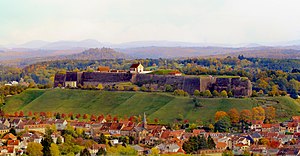Bitche | |
|---|---|
From top left: Citadel; Porte de Strasbourg and Sainte-Catherine Church; Saint-Augustin Chapel; Jardins pour la paix; Citadel's Chapel; Jardins pour la paix with the Sainte-Catherine Church in the background; Citadel viewed from the side; The Hasselfurt pond; Skyline from the citadel | |
| Coordinates: 49°03′09″N 07°25′48″E / 49.05250°N 7.43000°E | |
| Country | France |
| Region | Grand Est |
| Department | Moselle |
| Arrondissement | Sarreguemines |
| Canton | Bitche |
| Intercommunality | CC du Pays de Bitche |
| Government | |
| • Mayor (2020–2026) | Benoît Kieffer[1] |
Area 1 | 41.13 km2 (15.88 sq mi) |
| Population (2021)[2] | 4,958 |
| • Density | 120/km2 (310/sq mi) |
| Time zone | UTC+01:00 (CET) |
| • Summer (DST) | UTC+02:00 (CEST) |
| INSEE/Postal code | 57089 /57230 |
| Elevation | 249–432 m (817–1,417 ft) (avg. 290 m or 950 ft) |
| 1 French Land Register data, which excludes lakes, ponds, glaciers > 1 km2 (0.386 sq mi or 247 acres) and river estuaries. | |
Bitche (English pronunciation: /biːtʃ/ BEECH, French: [bitʃ]; German and Lorraine Franconian: Bitsch) is a commune in Moselle department, in the region of Grand Est in northeastern France. It is the Pays de Bitche's capital city, and the seat of the Canton of Bitche and the Pays de Bitche community of communes.
The town belongs to the Northern Vosges Regional Nature Park and is rated four-flowers in the towns and villages in bloom competition. The town's population at the 2013 census was 5,225. The inhabitants of the commune are known as Bitchois and Bitchoises.
The town is known for its large citadel originating from a castle built at the beginning of the 13th century. The fortress is noted for its resistance during the Franco-Prussian War. Its commander Louis-Casimir Teyssier held it for about eight months, with 3,000 men against about 20,000 Prussian and Bavarian soldiers, until the French government ordered him to surrender after the 1871 ceasefire. The town became part of Germany from that date until the end of the First World War, when it was given back to France. During the Second World War it was annexed by the Third German Reich (1940–1944).
- ^ "Répertoire national des élus: les maires" (in French). data.gouv.fr, Plateforme ouverte des données publiques françaises. 13 September 2022.
- ^ "Populations légales 2021" (in French). The National Institute of Statistics and Economic Studies. 28 December 2023.












